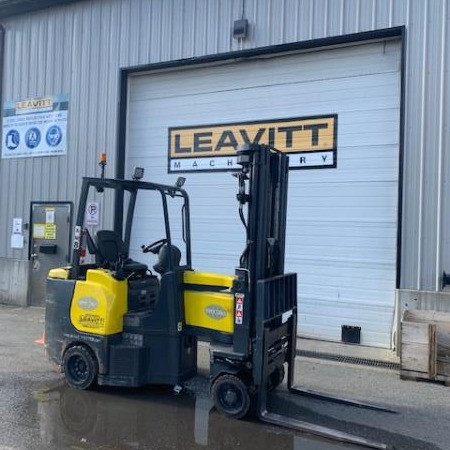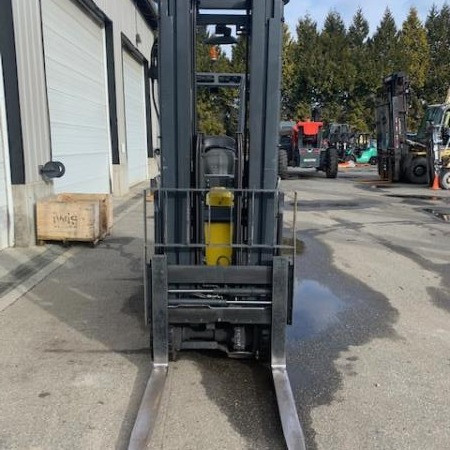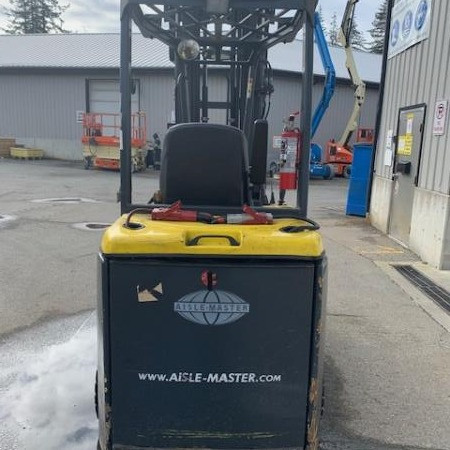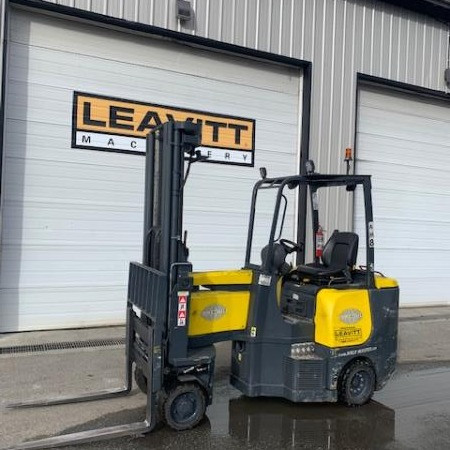Very Narrow Aisle Forklift Victorville
Used Very Narrow Aisle Forklift Victorville - Getting items from one warehouse location to another and to and from the loading docks is the focus of warehousing. Focus is often on space saving tools and the layout of the building. Narrow aisles need specific solutions to allow goods to be accessed and stored properly. More space can be given to storage as less space is needed for accessing the aisle. These warehouse configurations are often referred to as warehouse optimization.
Warehouse Optimization
Several benefits can be enjoyed for adding very narrow aisle warehouse optimization such as more storage space for the facility.
Using narrow forklift trucks instead of traditional forklifts can enable the warehouse width of the aisles can be lessened to half. Certain models of very narrow aisle forklifts can increase the square foot storage capabilities by delivering greater stacking heights. Very narrow aisle forklifts can greatly reduce costs compared to traditional forklifts since the same amount of stock takes up less space in the warehouse. In most urban areas where square footage is very costly, this is a huge benefit to warehouse operations. Warehouse storage can be increased up to eighty percent with careful planning when a narrow aisle width configuration is utilized. Very narrow aisle design facilitates greater product access and more rack faces. Reduced travel time for storing items and gathering products are some of the key benefits to this warehouse layout as more products are found in an accessible location.
Warehouse layouts usually utilize a narrow aisle or very narrow aisle plan. Less than eleven feet of aisle width is needed by narrow aisles. These widths reduce even further to roughly 6.5 feet for very narrow aisles. Both of these aisle widths provide significantly increased storage opportunities. Standard forklifts can have issues with turning in these aisle widths. To meet these challenges, several different types of very narrow forklifts have been specially developed for various types of tasks to allow easier maneuvering in narrow aisle widths.
Before choosing a forklift for a particular job, it is vital to know the dimensions of the aisle. Having the right aisle dimensions will save money and time instead of purchasing the wrong forklift that won’t be able to conquer the applications. It is essential to take any columns, posts or utilities into account before deciding a type of narrow aisle forklift design as these can block access.
Very Narrow Aisle Forklift Trucks
Very narrow aisle forklift trucks are almost always powered electrically, usually by rechargeable battery. Stand-up riders are a popular design for very narrow aisle forklift trucks. The most commonly used types of very narrow aisle forklift trucks are:
1. Reach trucks
2. Order pickers;
3. End-control riders; and
4. Turret or swing-mast.
Reach Forklift Trucks
The reach trucks were created as a type of rider stacker forklift but can be modified specifically for narrow aisle usage. This machine earned its name by its ability to reach its forks to secure a load. There are two types of reach trucks: the moving mast and the moving carriage. The moving carriage functions by lowering and raising the carriage and the operator. The moving mast works by raising and lowering the forks along the mast, while the operator stays at ground level. The moving mast reach truck is generally considered the safer of the two types of reach trucks. These machines rely on a kind of jointed framework known as a pantograph system that enables the operator to place a load or reach the load without moving the machine.
Order Pickers
Order pickers have been designed and developed specifically for use in picking orders from high, typically hard-to-reach racks. Order pickers are specific for lighter stock items that can be lifted by hand. These order pickers work by lifting the operator up to the level of goods in order to identify and pick the specific item or items necessary to fill an order.
End-Control Riders
End-control riders can pick up loads along the floor level and transport goods horizontally instead of transporting items over heights.
Turret or Swing-Mast Forklift
Turret or swing-mast very narrow aisle forklift have a pivoting articulating swivel mast. The mast swivels allowing pallets to be placed on either the left or right of the forklift.
Guided Very Narrow Aisle Trucks
Many very narrow aisle forklift trucks are able to be guided down aisles by wire or rail.
Since the forklift truck is guided, the chance of colliding with racks while traversing down the aisles is very low. In rail-guided models, sets of rails are placed into the floor on each side of the aisle. They run the length of the aisle and also curve around the aisles’ edge. Wheel guides on the forklift slide into the floor rails to stop the machine from traveling out of bounds.
Running down the center of the aisle, wire-guidance forklifts rely on floor wires instead of rails. These wire-guides work along the same principle as the rail guards except that the narrow aisle forklift is fitted with a wire-guide system that allows it to communicate with the floor wires which effectively steer the forklift, preventing it from straying outside of an allotted range.
Work Site Considerations
To use a narrow aisle configuration, there are some key considerations that need to be made. Because these very narrow aisle configurations include very tall racking systems, the condition of the floor and the construction of the racks must be done properly in order to avoid potentially disastrous outcomes. There are four areas which must be meticulously prepared before setting up a racking system and must be continuously monitored and maintained throughout the operation of the warehousing system:
1. The floor must be level;
2. Cracks must be repaired;
3. Load capacity of floor must be appropriate; and
4. The racks must be plumb.
Level Floor
Due to the racking system height, any minor floor slope can gravely impact how plumb the racks are, particularly over time if loads are placed and removed repeatedly on the racks. The height of the racking system means that any minute floor slope can have a negative impact on how straight the racks are, especially over time when loads are continually removed and placed on the racks. Without a level floor foundation, the rack stability could be compromised.
Crack Repair
When cracks in the floor are spotted, they should be assessed and, when necessary, repaired immediately. Safety can become compromised when flooring cracks become 3/8 inches wide. They require proper filling with a substance that is as hard as the floor.
Floor Load Capacity
Minimum flooring requirements must be met before considering a narrow aisle installation. Minimum flooring requirements include concrete measuring three thousand psi and rebar distributed evenly three to four inches below the surface. Depending on the load requirements and configuration, additional reinforcements may be needed.
Plumb Racks
The racking system is essential to the whole process and needs to be installed properly. If installed improperly, there is a great chance of rack failure. All racks need to be plumb and this is one of the most vital aspects of correct installation. Rack shims can help the rack stay plumb to one inch at the height of thirty feet.
If the above measures are not taken or are improperly implemented, it is likely to cause a racking failure. Racking failure can kill or injure employees, damage equipment and result in horrible damage. Because of these reason, these measures are the most important part of implementing a narrow aisle configuration for warehousing optimization.
Very Narrow Aisle Forklift PDF
Stock Number: 208758 GL
Make: AISLEMASTER
Model: 44SE
Year: 2015
| Stock Number |
208758 GL |
| Make |
AISLEMASTER |
| Model |
44SE |
| Year |
2015 |
| Category |
Very Narrow Aisle Forklift |
Stock Number: 209213 GL
Make: AISLEMASTER
Model: 44SE
Year: 2015
| Stock Number |
209213 GL |
| Make |
AISLEMASTER |
| Model |
44SE |
| Year |
2015 |
| Category |
Very Narrow Aisle Forklift |
Stock Number: 207213 GL
Make: AISLEMASTER
Model: 44E
Year: 2013
| Stock Number |
207213 GL |
| Make |
AISLEMASTER |
| Model |
44E |
| Year |
2013 |
| Category |
Very Narrow Aisle Forklift |













